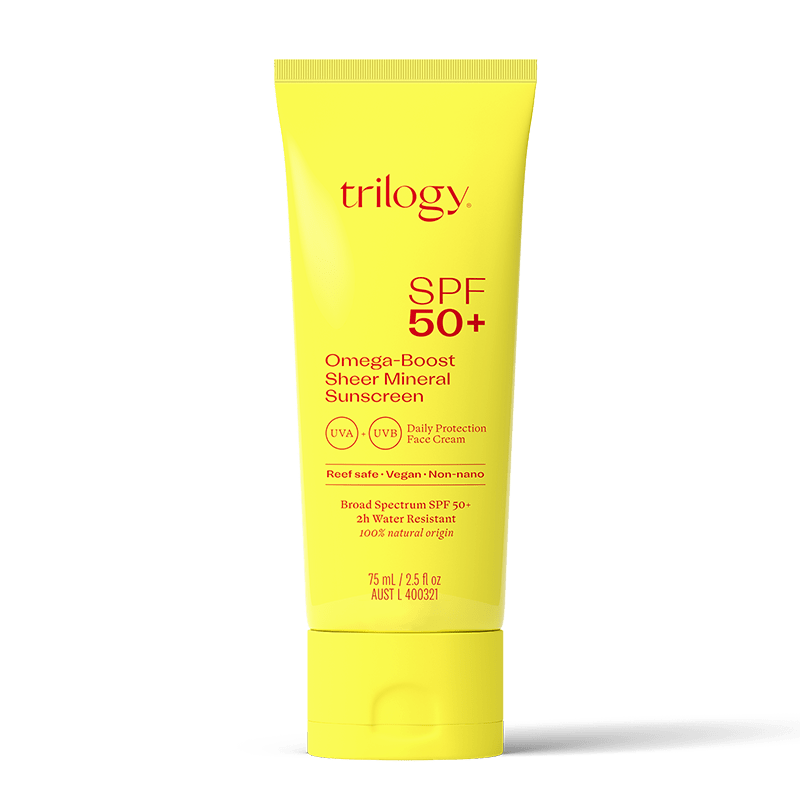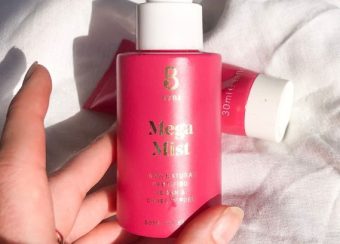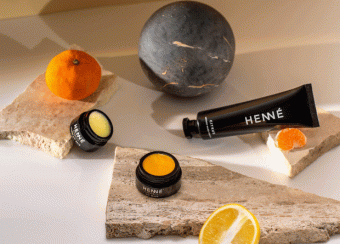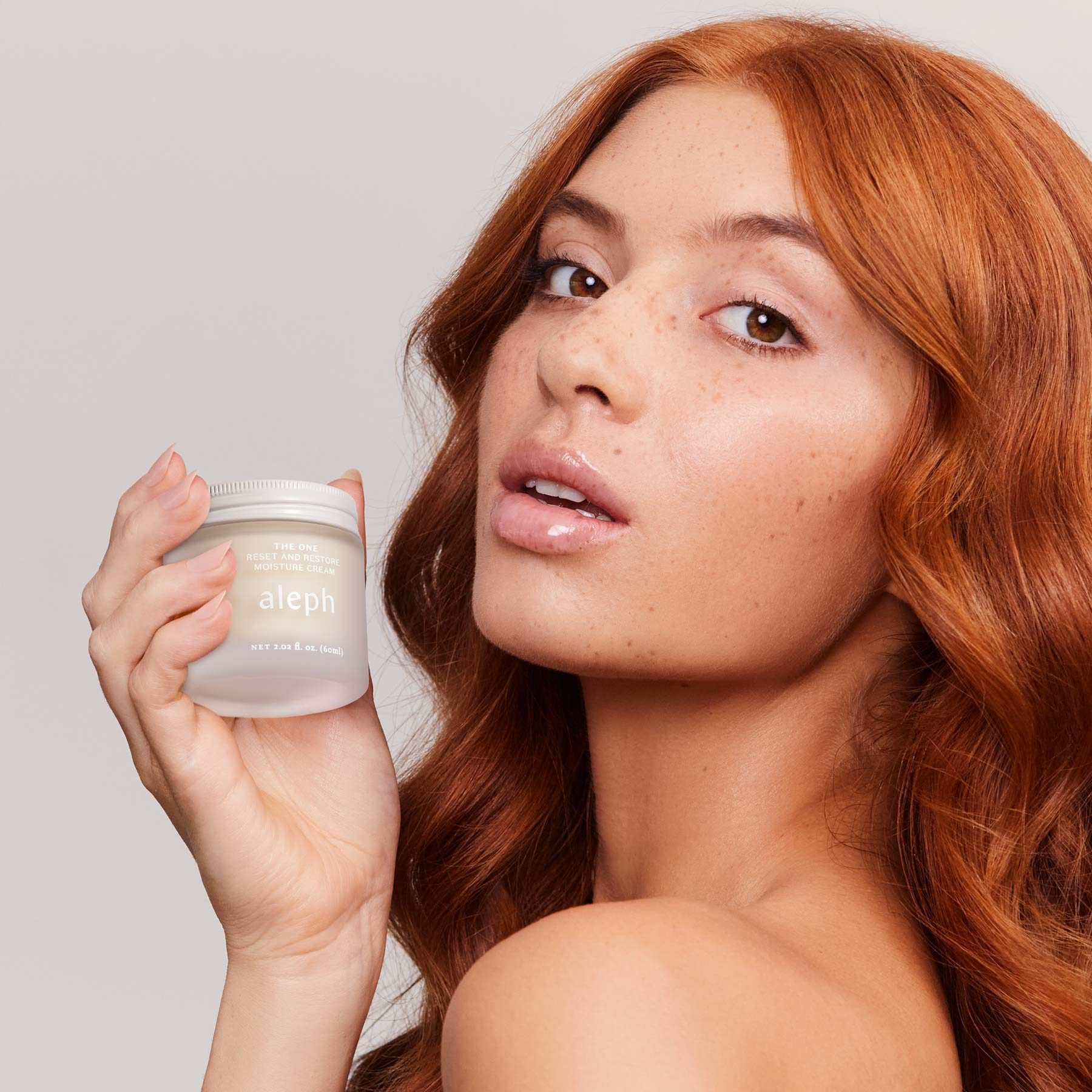The lowdown on Trilogy’s new SPF50+ Omega Boost Sheer Mineral Sunscreen
31/12/2023 2023-12-31 17:04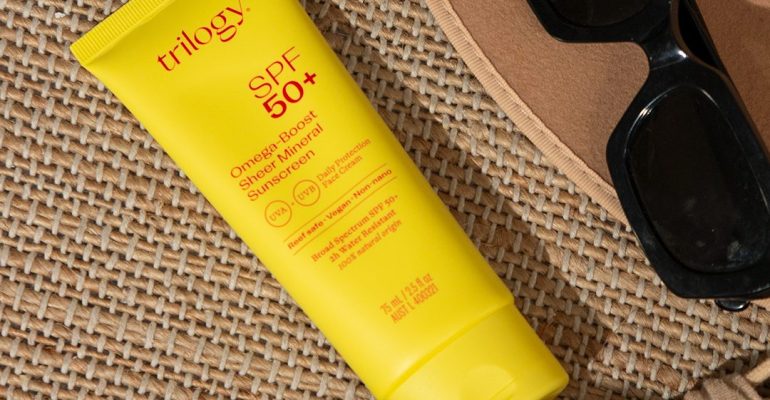
The lowdown on Trilogy’s new SPF50+ Omega Boost Sheer Mineral Sunscreen
A high SPF broad spectrum sunscreen is your ultimate anti-ageing essential for braving the elements in every season, intercepting skin damage before it happens and laying the foundations for your other skincare products to work their magic.
When Trilogy innovated their Omega-Boost Sheer Mineral Sunscreen they made sure everything from their UV filters to their SPF number was backed by solid sun care science – because when it comes to locking in youthful, healthy skin, some steps are too important to skip.
Unpacking UV rays
To understand why a solid SPF formula is the ultimate anti-ageing shield, we need to take a look at how UV (or ultra-violet) rays from the sun interact with our skin in the first place.
Simply put, UV radiation is what causes ‘sun damage’ as we know it, passing through and ageing the layers of our skin bit-by-burning-bit. Sun rays are made up of three different kinds of radiation, each with their own characteristics:
UVA – Also known as ‘ageing rays’, UVA rays make up 95% of the radiation
that reaches the earth’s surface. These rays pass deep into the skin, causing
damage and premature ageing as they go.
UVB – Making up the other 5% of radiation from the sun, UVB rays don’t
penetrate the skin quite as deeply as UVA rays, but are still potent enough to
cause sunburns and blistering.
UVC – These rays are just as strong as UVA and UVB, but thankfully can’t
make it through the earth’s atmosphere – that’s one less ray to worry about!
The sun produces all of these rays year-round and it doesn’t take a break over winter, meaning no matter how cold it is outside, it always pays to be SPF-savvy.
How sun rays age our skin
While soaking up the sunshine might make us feel rejuvenated and energetic after being cooped up inside or stuck in the rain, at a cellular level UV rays are anything but welcome.
When UV rays of any kind hit the skin and sink into the epidermis, they damage its DNA and make our skin cells scramble to produce more melanin to defend itself. When this process happens over and over again, it causes ‘photoaging’ – premature skin ageing due to ongoing UV ray exposure.
While natural skin ageing tends to happen gradually, without proper sun protection photoaging can set in at any time, bringing with it hyperpigmentation, uneven skin tone, broken capillaries, fine lines, wrinkles and more.
They’re all skin concerns we could happily do without, but thankfully with high UV protection, know-how and reliable SPF50+ formula, they’re also mostly preventable.
Decoding SPF – what is it, and how does it work?
We all know that top-quality sun protection requires a top-quality SPF formula, but what does that actually mean and how can we work out which sunscreens do it best? Let’s break down the term ‘SPF50+’ and look at each part in isolation:
The ‘SPF’ part
SPF’ stands for ‘Sun Protection Factor’, and refers specifically to protection from sunburn-causing UVB rays.
The number
The number that follows ‘SPF’ on a sunscreen indicates the percentage of UVB rays it protects you from. SPF50 for example protects the skin from around 98% of UVB exposure, whereas SPF30 and SPF15 protect it from 97% and 93% respectively.
The plus sign
Whenever you see a ‘+’ after a SPF number, it means that the formula contains ‘more than’ whichever number it follows, meaning SPF50+ sunscreens like our NEW Omega-Boost Sheer Mineral Sunscreen have reached an impressive SPF60 in testing.
Broad spectrum
This descriptor proves that the formula protects skin not only from UVB rays, but skin-ageing UVA rays as well.
Physical sunscreen vs. chemical sunscreen
All sunscreens use either physical filters, chemical filters, or a blend of the two to protect the skin from damaging UV rays.
Chemical sunscreens sink into the epidermis and absorb damaging rays so the skin doesn’t have to, converting them into heat and releasing them from the body. These types of formulas apply on skin easily, but can be irritating for sensitive skin and can also contain synthetic chemicals that harm coral reefs.
Physical sunscreens sit on the surface of the skin to create a reflective barrier, bouncing UV rays off the skin and back into the atmosphere. They usually contain naturally-derived minerals, which are gentle on the skin but can be greasy to apply.
To suit discerning skincare-lovers everywhere, we’ve carefully formulated NEW Omega-Boost Sheer Mineral Sunscreen to combine the best of both formula types with none of the drawbacks – a non-whitening physical sunscreen that’s sensitive-skin friendly, lightweight, and easy on the planet (in this case, reefs) too.
Staying smarter in the sun
While sunscreen should always act as your first line of defence against skin ageing, there are lots of other sun-safe practices you can pair with a good SPF for serious protection in any season.
A handy rule of thumb in both summer and winter is to avoid the sun between 11am – 3pm and to reapply your sunscreen frequently – especially if you’ve been swimming, exercising or towel-drying.
If avoiding the sun entirely just isn’t an option, chuck on a broad-brimmed hat and sunglasses and opt for protective clothing with thicker fabrics whenever you can.
It’s all part of the youth-preserving process, and definitely worth making a habit of to lock in and protect your best skin ever. See you out there, and happy sunscreen-ing!
FAQs
Trilogy have spent years perfecting their first SPF50+ sunscreen so that it’s natural, powerfully protective and luxurious to use. And the response they’ve had has blown them away. But to answer some of your burning questions, see below.
Q: Do I use Omega-Boost Sheer Mineral Sunscreen with a moisturiser as well?
Yes, absolutely! Both steps have their main purpose (moisturiser – hydrates & can target skin concerns, SPF – protects from UV rays).
However, you don’t have to. It really depends on your skin type and what your skin needs. Does it feel good with both? Perfect! Does it feel too heavy? See next Q.
Q: When I use my moisturiser & SPF together, I’m finding it a bit greasy. Is this expected?
Sometimes the combo can feel too much, especially if your skin type is oily and/or you’re using a heavier cream moisturiser. Try pairing it with a ligher lotion, or use our the Omega-Boost Sheer Mineral Sunscreen alone as your SPF + moisturiser – its base formula has added omega-rich oils and vitamin E, so it nourishes and hydrates as well as protects. A welcomed 2-in-1!
Q: How much should I put on my face?
A general rule of thumb is around 1 tsp for your face and neck, or what feels a liberal amount to ensure good coverage. Rub in thoroughly and give it a couple of minutes to really sink into your skin – at least 20 minutes before leaving the house.
Q: I’m finding it leaves a white cast on my skin. Is this normal?
Since the Omega-Boost Sheer Mineral Sunscreen uses a natural mineral filter (zinc oxide) it can appear to leave a small white cast… but only momentarily! After applying 1 tsp of sunscreen to face and neck, give it a couple of moments to sink into the skin, then any ‘white cast’ you’re seeing should dissipate and leave a glowy, dewy finish.
Q: Do I REALLY need to use facial SPF year-round?
YES, really. Both UVA (ageing rays) UVB (burning rays) reach the earth’s surface year-round – which means they can always harm and cause pre-mature ageing. While both UV rays cause harm, UVA penetrate deeper into the skin, and you don’t often see the visible burn as much as UVB (eg. on unprotected skin, you’re still getting sun damage when you can’t see any visible burn).
Q: Can I use it on my body?
You can absolutely use it on your body! It is more specifically designed as a face & neck sunscreen and as the last step in your morning skincare routine, but no one has ever said you can’t have a luxury full body sunscreen.
Q: Is it safe to use when I’m pregnant and on my kids?
Absolutely, our entire range is pregnancy friendly. It is suitable for the family, but babies under 6 months old we recommend seeking medical advice before use.
Q: I have sensitive skin, is your Omega-Boost Sheer Mineral Sunscreen for me?
Yes, yes, yes! Our SPF is Dermatologically tested, so it is tested to not irritate skin. And with a natural mineral sun filter (zinc oxide) and natural base formula, there are no hidden nasties to flare up sensitivities. Zinc oxide even helps calm sensitive skin.
Q: Sunscreen normally makes me breakout! Will this happen with yours?
Argh, we hear you! Often mineral sunscreens can create a film on your skin that blocks pores which can be the cause of breakouts. Exactly why we had our Omega-Boost Sheer Mineral Sunscreen independently tested non-comedogenic –aka. It doesn’t clog pores.
Q: Does it sit well under makeup?
We love it under make-up! Its dewy, glowy finish makes it a great primer.
Q: Does your SPF comply with sun safety standards?
Yes! We take your sun safety extremely seriously. Trilogy Omega-Boost Sheer Mineral Sunscreen meets Australasian standards which are some of the most robust in the world (AS/NZS 2604:2021).

